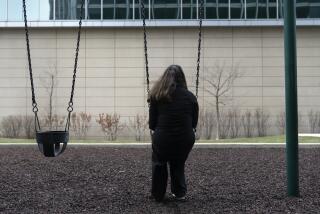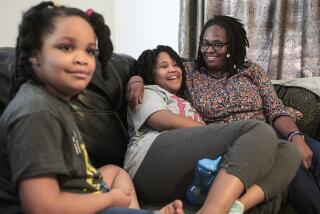Youths may be over-diagnosed as bipolar
- Share via
The diagnosis of bipolar disorder in children and adolescents has risen fortyfold since 1994, according to a study released Monday. But researchers partly attributed the dramatic rise to doctors over-diagnosing the serious psychiatric disorder.
The report in the journal Archives of General Psychiatry said bipolar disorder was found in 1,003 of every 100,000 office visits from children and adolescents in 2002-03, compared with 25 of 100,000 office visits in 1994-95.
The diagnosis of bipolar disorder among adults increased twofold during the same period, researchers said.
The study didn’t investigate the reasons for the sudden rise in bipolar cases among children and adolescents. A book published in 2000, “The Bipolar Child,” made the controversial assertion that one-third to one-half of children with depression had bipolar disorder.
Dr. Mark Olfson, a psychiatrist at Columbia University’s College of Physicians and Surgeons and senior author of the latest study, said part of the increase was attributable to an under-diagnosis of bipolar disorder in the past.
But Olfson said another reason was the mislabeling of children and adolescents with aggressive or irritable behaviors as bipolar, an illness that is treated with powerful psychotropic medications, many of which have not been tested in children.
Dr. Thomas R. Insel, director of the National Institute of Mental Health, which funded the study, called the increase in bipolar diagnoses worrisome.
“The way the label is being used is probably a little exuberant -- not fitting with the strict definition of the illness,” Insel said. The disorder “is probably not as common as the very high rates we’re seeing.”
Bipolar disorder is marked by severe mood swings between depression and mania, which is characterized by an excess of energy and restlessness. For most patients, depressive episodes are three times more common and longer lasting than those of mania. Symptoms of the disorder can interfere with daily activities, and severe cases carry a risk of suicide.
Until recently, the illness, which appears to run in families, was seldom diagnosed in children. It was believed to begin in late adolescence or early adulthood. About 2% of American adults are believed to have bipolar disorder, although not all of them have been diagnosed.
In the latest study, researchers analyzed data from an annual national survey that collected information from doctors about the nature of patient visits.
Researchers found striking differences between adults and the young. Among children and adolescents, boys were more likely to be diagnosed with bipolar disorder. Among adults, it is more common in women.
Olfson said the gender difference between the groups suggested that some boys with behavior problems or conduct disorders were being misdiagnosed as bipolar. Irritability is a characteristic of bipolar disorder, he said, but it is also a normal part of adolescence.
“The definition of bipolar disorder tells us what it looks like in adults but not in children,” Olfson said.
Young people were 10 times more likely to also receive a diagnosis of attention deficit hyperactivity disorder than bipolar adults, the report noted. Olfson said it was likely that some children with ADHD received the additional diagnosis of bipolar disorder because the symptoms of the two illnesses overlapped. For example, he said, some children and adolescents with ADHD have a “volatile, aggressive subtype” that is easily confused with bipolar disorder.
The report found that children and adolescents diagnosed with bipolar disorder received the same medication as adults with the illness. Sixty percent of children and adolescents received a mood stabilizer, and about 33% of them received an antidepressant or antipsychotic medication, which can cause weight gain.
Dr. Gabrielle A. Carlson, a psychiatrist at Stony Brook University in New York, said 1 of every 5 children referred to her with a diagnosis of bipolar disorder actually had it. The rest had autism, depression, anxiety or another psychological disorder. All these conditions involve different treatments, with drugs, behavioral therapy or both.
Carlson, who has studied the increase in bipolar diagnoses, said some parents seemed to prefer a diagnosis of the disorder because the illness, which is thought to be largely genetic, absolves them of blame.
“They don’t have to deal with their chaos, their psychiatric disorder, their marital troubles or abuse,” she said.
She said that in some cases, providers would diagnose psychological problems in children as bipolar disorder to obtain insurance reimbursement for hospitalizations, a practice called upcoding.
Insel said his institute was conducting research that might lead to more accurate diagnoses of bipolar disorder in young people. The agency said recent imaging studies had detected differences between the brains of normal children and those with bipolar disorder.
A large study looking for the genes responsible for the disorder is nearing completion and may yield some additional clues, Insel said.
The agency is also tracking children with bipolar disorder to see how their symptoms change over time. Only a small fraction of children referred for the study actually had bipolar disorder, Insel said, another indication that the label is misused.
“We urgently need to improve diagnosis and treatment for these kids with severe emotional problems,” he said.






